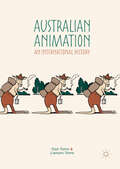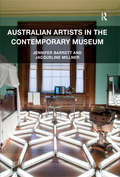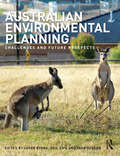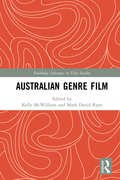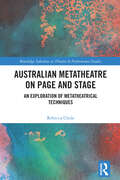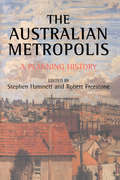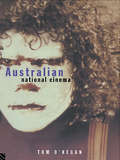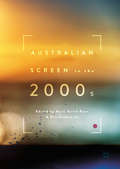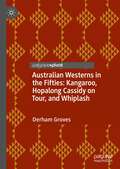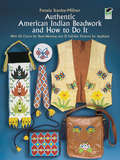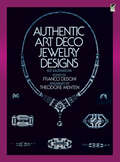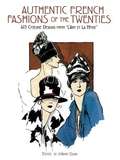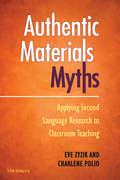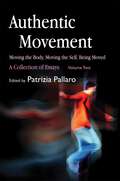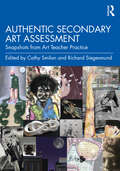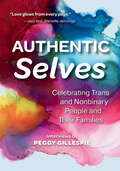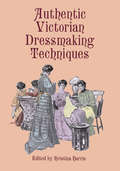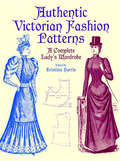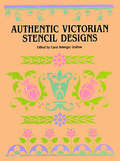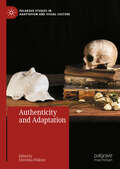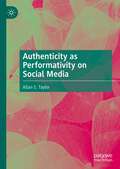- Table View
- List View
Australian Animation: An International History
by Dan Torre Lienors TorreThis book provides the most comprehensive history and analysis of Australian animation published to date. Spanning from the 1910s to the present day, it explores a wide-range both of independent animation, and of large-scale commercial productions. Presented within a uniquely international context, it details the frequent links between Australian animation and overseas productions. New perspectives and original information are offered on a variety of international subjects such as: Felix the Cat, the Australian Hanna-Barbera studios, and the Australian Walt Disney studios. Drawing on both extensive archival research and original interviews this book illuminates, for the first time, the breadth and richness of Australia’s animation history.
Australian Artists in the Contemporary Museum
by Jennifer Barrett Jacqueline MillnerThis unique book proposes a re-reading of the relationship between artists and the contemporary museum. In Australia in particular, the museum has played a significant role in the colonial project and this has generally been considered as the predominant mode of artists' engagement with such institutions and collections. Australian Artists in the Contemporary Museum expands the post-colonial frame of reference used to interpret this work, to demonstrate the broader implications of the relationship between artists and the museum, and thus to offer an alternative way of understanding recent contemporary practices. The authors' central argument is that artists' engagement with the museum has shifted from politically motivated critique taking place in museums of fine art, towards interventions taking place in non-art museums that focus on the creation of knowledge more broadly. Such interventions assume a number of forms, including the artist acting as curator, art works that highlight the use of taxonomic modes of display and categorization, and the re-consideration of the aesthetics of collections to suggest different ways of interpreting objects and their history. Central to these interventions is the challenge to better connect the museum and its public. The book will be essential reading for scholars, professionals and students in the fields of contemporary art and museum studies, art history, and in the museum sector. These include artists, curators, museum and gallery professionals, postgraduate researchers, art historians, designers and design scholars, art and museum educators, and students of visual art, art history, and museum studies. This project has been assisted by the Australian government through the Australia Council for the Arts, its arts funding and advisory body.
Australian Environmental Planning: Challenges and Future Prospects
by Neil Sipe Jason Byrne Jago DodsonWinner of the Planning Institute of Australia's 2015 Cutting Edge Research and Teaching Award! Australians from all walks of life have begun to realise the nation’s cities cannot sustain profligate growth indefinitely. Dwindling water supplies, failing food bowls, increased energy costs, more severe bushfires, severe storms, flooding, coastal erosion, rising transport expenses, housing shortages and environmental pollution are now daily news headlines. Australia’s cities may have reached their ecological limits: a new model for planning the places we live is needed. Understanding the natural cycles of the city is just as important to planning our cities as knowledge of local ordinances, indeed much more so. A profound knowledge of environmental processes is critical for successful planning in today’s world. Environmental planners take as their guiding principle the concept of designing with nature, approaching cities as living organisms that consume water, energy and raw materials, and produce waste. This metabolic view of cities means we can find new solutions to old problems, and steer our cities towards a more sustainable form of planning. Written specifically for students and professionals working in city planning in Australia, this ground-breaking new book enables Australian planners, architects and developers to get a better understanding of the fundamental principles of environmental planning for cities, showing how land, water, air, energy, wildlife and people shape our built environments, and how in turn environmental processes must be better understood if we are to make informed decisions about developing cities that are more sustainable. The book’s coverage is comprehensive: from an overview of the concepts and theories of environmental planning, through analysis of governance systems and urban environmental processes to agendas and policies for the future, all the key topics are covered in depth, with recommendations for supporting reading and an unrivalled selection of additional materials. Ideal for students, essential for professionals, Australian Environmental Planning is vital reading for more sustainable cities in a more sustainable world.
Australian Genre Film (Routledge Advances in Film Studies)
by Kelly McWilliamAustralian Genre Film interrogates key genres at the core of Australia’s so-called new golden age of genre cinema, establishing the foundation on which more sustained research on film genre in Australian cinema can develop. The book examines what characterises Australian cinema and its output in this new golden age, as contributors ask to what extent Australian genre film draws on widely understood (and largely Hollywood-based) conventions, as compared to culturally specific conventions of genre storytelling. As such, this book offers a comprehensive and up-to-date survey of Australian genre film, undertaken through original analyses of 13 significant Australian genres: action, biopics, comedy, crime, horror, musical, road movie, romance, science fiction, teen, thriller, war, and the Western. This book will be a cornerstone work for the burgeoning field of Australian film genre studies and a must-read for academics; researchers; undergraduate students; postgraduate students; and general readers interested in film studies, media studies, cultural studies, Australian studies, and sociology.
Australian Metatheatre on Page and Stage: An Exploration of Metatheatrical Techniques (Routledge Advances in Theatre & Performance Studies)
by Rebecca ClodeThis book offers the first major discussion of metatheatre in Australian drama of the late twentieth and early twenty-first centuries. It highlights metatheatre’s capacity to illuminate the wider social, cultural, and artistic contexts in which plays have been produced. Drawing from existing scholarly arguments about the value of considering metatheatre holistically, this book deploys a range of critical approaches, combining textual and production analysis, archival research, interviews, and reflections gained from observing rehearsals. Focusing on four plays and their Australian productions, the book uses these examples to showcase how metatheatre has been utilised to generate powerful elements of critique, particularly of Indigenous/non-Indigenous relations. It highlights metatheatre’s vital place in Australian dramatic and theatrical history and connects this Australian tradition to wider concepts in the development of contemporary theatre. This illuminating text will be of interest to students and scholars of Australian theatre (historic and contemporary) as well as those researching and studying drama and theatre studies more broadly.
Australian Metropolis: A Planning History (Planning, History and Environment Series #Vol. 25)
by Hamnett Stephen Freestone RobertThe Australian Metropolis splendidly fills a huge gap in the literature on Australian cities. It is the definitive account of the history of Australian cities and the crucial role which planning has played in their genesis and growth. Spanning two centuries from the very beginning until the present day, it will instantly become a standard work ' Professor Sir Peter Hall, author of Cities in Civilisation..The Australian Metropolis provides a single-volume introduction to the development of urban planning. It fills the need for a convenient, initial resource for anyone interested in the broad evolutionary sweep of modern planning. By setting the evolution of Australian planning within its broader societal context, The Australian Metropolis presents a balanced appraisal of the positive, negative and ambivalent legacies resulting from attempts to plan Australia's major cities. This book is the winner of two Royal Australian Planning Institute Awards for Planning Excellence in 2000/2001, including the New South Wales' Division Prize for Planning Scholarship in February 2001.
Australian National Cinema
by Tom O'ReganTom O'Regan's book is the first of its kind on Australian post-war cinema. It takes as its starting point Bazin's question 'What is cinema?'and asks what the construct of a 'national' cinema means. It looks at the broader concept from a different angle, taking film beyond the confines of 'art' into the broader cultural world. O'Regan's analysis situates Australian cinema in its historical and cultural perspective producing a valuable insight into the issues that have been raised by film policy, the cinema market place and public discourse on film production strategies. Since 1970 Australian film has enjoyed a revival. This book contains detailed critiques of the key films of this period and uses them to illustrate the recent theories on the international and Australian cinema industries. Its conclusions on the nature of the nation's cinema and the discourses within it are relevant within a far wider context; film as a global phenomenon.
Australian Screen in the 2000s
by Mark David Ryan Ben GoldsmithThis book provides coverage of the diversity of Australian film and television production between 2000 and 2015. In this period, Australian film and television have been transformed by new international engagements, the emergence of major new talents and a movement away with earlier films' preoccupation with what it means to be Australian. With original contributions from leading scholars in the field, the collection contains chapters on particular genres (horror, blockbusters and comedy), Indigenous Australian film and television, women's filmmaking, queer cinema, representations of history, Australian characters in non-Australian films and films about Australians in Asia, as well as chapters on sound in Australian cinema and the distribution of screen content. The book is both scholarly and accessible to the general reader. It will be of particular relevance to students and scholars of Anglophone film and television, as well as to anyone with an interest in Australian culture and creativity.
Australian Westerns in the Fifties: Kangaroo, Hopalong Cassidy on Tour, and Whiplash
by Derham GrovesAustralian Western in the Fifties: Kangaroo, Hopalong Cassidy on Tour, and Whiplash looks at Australian Westerns from three points of view—film, personal appearance, and television at the beginning, middle, and end of the 1950s, the American Western’s golden age. It looks at three significant but “forgotten” cases: (1) Kangaroo: The Australian Story, the first Technicolor film made in Australia, produced by the Hollywood movie studio 20th Century Fox, directed by the Academy Award-winning filmmaker Lewis Milestone, starring Maureen O’Hara, Peter Lawford, and Richard Boone. (2) The successful goodwill tour of Australia by the Hollywood actor William Boyd who played the film, radio, and television cowboy Hopalong Cassidy. (3) The British-American produced black-and-white TV series Whiplash, made in Australia and starring the Hollywood actor Peter Graves. The American filmmakers’ ignorance of Australia meant they learned the hard way there was more to Australian Westerns than simply replacing the prairie with the bush, bison with kangaroos, and Native Americans with Aboriginals. Indeed, the depiction of place and the presentation of Aboriginal culture are two of the most intriguing aspects of Australian Westerns. In retelling the filmmakers’ stories, a unique picture of the Australian film and television industry and everyday life during the 1950s is revealed.
Authentic American Indian Beadwork and How to Do It: With 50 Charts for Bead Weaving and 21 Full-Size Patterns for Applique
by Pamela Stanley-MillnerCraftspeople who admire striking Indian designs can now create beautiful, colorful beadwork originated by the Chippewa, Iroquois, Pawnee, Seminole, Winnebago, and other American Indian tribes.This book is a complete guide to this time-honored handicraft, offering step-by-step instructions, clear diagrams, and 71 tribal designs for two types of traditional bead applications -- bead weaving and appliqué beading. You'll find fifty versatile designs charted on graph paper for bead weaving and twenty-one full-size patterns for appliqué, including transfer instructions and color keys. Easy-to-follow directions tell you how to construct your own bead loom.Choose from a rich array of motifs rendered from authentic American Indian artifacts found in museum collections -- stars, exciting geometrics, sunbursts, exquisite florals, and much more.Beadcrafting is surprisingly easy to learn, offering hours of enjoyment and satisfaction. Follow the charts to weave belts, headbands, sashes, necklaces, and other eye-catching accessories. Use the appliqué patterns to decorate leather, denim, and other fabrics for handbags, vests, blouses...anything that would be enhanced by a touch of distinctive Indian beadwork.With this inexpensive do-it-yourself book, you can create beautiful projects for yourself and your family and memorable gifts -- for a fraction of the price you'd pay in a store.
Authentic Art Deco Jewelry Designs (Dover Jewelry and Metalwork)
by Franco DeboniThrough the peak period of Art Deco creativity in the 1920s, many artists and studios produced portfolios of original designs for commercial use. Often these original works went unsigned and, after inspiring their limited, exclusive audience, disappeared. Here is one such portfolio (most likely French or German, 1925-30) recently rediscovered and now reproduced as an original and probably unique document of the Art Deco years.Over 800 royalty-free jewelry designs and motifs dazzle with Art Deco invention: buckles, buttons, clips, belts, mirrors, pendants, cigarette cases, rings, chains, necklaces, watchbands, brooches, studs, clusters of intricate, delicate, sharp-edged Art Deco charms, many graced with the too-often forgotten humor and wit lying just beneath the geometry.Jewelry designers, collectors of Art Deco, and period specialists will find equal amounts of inspiration and aesthetic delight in this rare, precisely executed collection of fresh, authentic Art Deco design, now rescued from oblivion. Artists, designers, and crafters will find it a valuable Art Deco treasury.
Authentic Color Schemes for Victorian Houses: Comstock's Modern House Painting, 1883
by E. K. Rossiter F. A. WrightWhen the authors, a pair of respected architects, first published this beautiful book in the late Victorian era, they meant it as a wakeup call to the forward-looking homeowners of the time — inviting them to eschew "the old puritanical hatred of color, which found its natural outcome in white houses with green blinds" and join in the revolutionary trend toward "advanced notions, in which the more positive colors find a chance of expression." The book helped homeowners to attain this goal through its presentation of full-color illustrations of attractive, up-to-date color schemes for houses, with special attention given to the refined lines of Queen Anne-style homes.The heart of the book is the section of 20 exquisite color plates — each reproducing a flawlessly executed architectural drawing that shows the color possibilities for a specific house, and each accompanied by an extensive written description of the colors to be used for exterior walls and trim. An informative introductory section gives a clear explanation of how to mix primary and secondary colors to achieve such popular, mellow tones of the period as olive, russet, citrine, buff, plum, and sage. This authentic source of inspiration and suggestions will be prized by restorationists, architects, home-builders, and lovers of Victoriana.
Authentic French Fashions of the Twenties: 413 Costume Designs from "L'Art Et La Mode"
by Joanne OlianIn the 1920s, fashion magazines were the principal source for news of the latest Paris couture. One of the most famous and long-lived of these journals was L'Art et la Mode, published from 1880 to 1967. L'Art et la Mode captured the glamor that was Paris in the Twenties, from days at the races to nights at the opera, from Sundays at the Ritz to Saturdays at the Folies-Bergère, and it followed the glittering circuit that flourished from Longchamps to Deauville to Cannes to Biarritz. The magazine was read avidly not only by the rich who patronized the couture, but also by the woman who relied on her "little dressmaker" to copy the styles depicted in the periodical. This lavishly illustrated volume offers 138 dazzling pages from L'Art et la Mode featuring fashions for all occasions by the great French couturiers of the Twenties--Patou, Worth, Molyneux, Doucet, Paquin, Vionnet, Lanvin, and Chanel among them. Selected by JoAnne Olian, curator of the famed Costume Collection at the Museum of the City of New York, a wealth of designs include stylish outfits for winter sports, hunting season, tennis, golf, and other athletic pursuits, as well as high-fashion ensembles for soirées and all manner of chic divertissements. In addition to choosing the plates, Ms. Olian has also provided an excellent introduction discussing the magazine, the period, and its fashion trends. The result is a beautifully illustrated, sumptuous look back at one of haute couture's most influential decades. It is also an outstanding and inexpensive source of copyright-free fashion illustrations for use by designers and craftspeople.
Authentic Indian Designs (Dover Pictorial Archive)
by Maria NaylorLargest collection anywhere: 2,500 authentic illustrations of bowls, bottles and pipes, geometric and floral patterns on beadwork, pictographs, symbolic tipi decorations, masks, basket weaves, Hopi katchina figures, much more.
Authentic Materials Myths: Applying Second Language Research to Classroom Teaching
by Charlene Polio Eve ZyzikThe use of authentic materials in language classrooms is sometimes discussed as a reliable way to expose students to the target language, but there is also disagreement regarding what kinds of authentic materials should be used, when they should be used, and how much of the curriculum should revolve around them. This volume in the Myths series explores the research related to the use of authentic materials and the ways that authentic materials may be used successfully in the classroom. Like others in the Myths series, this book combines research with good pedagogical practices. The myths examined in this book are: Authentic texts are inaccessible to beginners.Authentic texts cannot be used to teach grammar.Shorter texts are more beneficial for language learners.Activating background knowledge or making a word list is sufficient to prepare students for authentic texts.Authentic texts can be used to teach only listening and reading.Modifying or simplifying authentic texts always helps language learners.For learners to benefit from using authentic texts, the associated tasks must also be authentic.The Epilogue explores the challenges of using authentic texts in the classroom and calls for more research.
Authentic Movement: A Collection of Essays - Volume Two
by Patrizia PallaroPraise for the first volume: `It is very valuable to have [this collection of articles] all together in one place...a rich repository of insights and experiences for all the somatic disciplines. It is a wonderful collection of articles.' - Somatics 1999/2000 This second volume on Authentic Movement - a new discipline aiding the creative process in choreography, writing, theatre performance, dance, graphic and expressive arts, as well as spirituality - is an engaging and dynamic collection of scholarly essays, personal stories, practical suggestions and resources. It reflects cutting edge work on creative expression, meditative discipline and psychotherapeutic endeavour. Part I comprises five chapters written by the most prominent Authentic Movement practitioners and teachers and introducing the foundations and principles of Authentic Movement. In Part II, the contributors return to the source of Authentic Movement - the psychotherapeutic setting - and provide an in-depth examination of the personal processes in the therapeutic relationship and the potential of Authentic Movement to facilitate personal growth and change. Part III traces the development of Authentic Movement as a spiritual path and as interface with other spiritual practices. Part IV provides an overview of new developments in Authentic Movement, Part V offers inspiring personal accounts and Part VI provides guidelines drawn from practice as well as tools and resources. These latter chapters sow the seeds for a new understanding and directions for the developments of Authentic Movement. This authoritative text is indispensable for practitioners of Authentic Movement, students and teachers working in the field of dance therapy, art therapists, all creative arts therapists and body psychoanalysts.
Authentic Secondary Art Assessment: Snapshots from Art Teacher Practice
by Richard Siegesmund Cathy SmilanOffering a contemporary overview of how visual art teachers assess learning in their classrooms, this book provides an outline of the role of assessment in reporting not only student achievement but also how student assessment ties to the intrinsic and external assessments of teacher performance. Compiled using stories from the classrooms of 19 visual art high school teachers who share their approaches to benchmarking student success, the text encourages teachers to consider assessment both for guiding their students to achieve artistic goals and for re-envisioning their own curriculum and instruction. The featured assessment snapshots fall along four strands: Visual Narratives and Visual Literacy; Capturing Empathic Understandings and Social Engagement; Measuring Risk-taking and Ingenuity; and Assessing Collaborative and Integrated Learning Outcomes. Across these sections, teacher contributors offer different perspectives for student assessment, capturing a snapshot of the work of skilled practitioners and focusing on various aspects of what can be evidenced and analyzed through formative and summative evaluation. The voices of university level art educators are also included to expand the range of context from curriculum and instruction content that is covered in pre-service art methods courses. All sections also conclude with a summary, questions, and discussion points. Including diverse teacher voices as well as presenting assessment perspectives with an eye to the National Core Art Standards (NCAS), this book is ideal for pre-service and in-service secondary art educators, as well as for use in art education teacher certification courses that focus on secondary methods, and art education graduate classes in assessment.
Authentic Selves: Celebrating Trans and Nonbinary People and Their Families
by Jeff MillerGroundbreaking in its depictions of joy and community, Authentic Selves celebrates trans and nonbinary people and their families in stunning photographs and their own words. Foreword by transgender activist Jazz Jennings and her mom and fellow activist, Jeanette Jennings.So often trans and nonbinary people’s stories are told only through the lens of their struggles and challenges, including their political battles for legal rights, but trans and nonbinary people live rich and fulfilling lives full of joy and community too. Authentic Selves: Celebrating Trans and Nonbinary People and Their Families is a sweeping compilation of life stories and portraits of trans and nonbinary people, as well as their partners, parents, children, siblings, and chosen family members.The compelling stories in Authentic Selves provide a glimpse into the real lives, both the challenges and the triumphs, of these remarkable people and their families—people like Senator Sarah McBride, disability justice advocate Parker Glick, drag entertainer TAYLOR ALXNDR, September 11th first responder Jozeppi Angelo Morelli, model Lana Patel, youth activist Elliott Bertrand, and so many others—all of whom are working to create a more just, diverse, and compassionate world.Developed in collaboration with PFLAG National and Transgender Legal Defense & Education Fund.
Authentic Selves: Celebrating Trans and Nonbinary People and Their Families
by Jeff MillerGroundbreaking in its depictions of joy and community, Authentic Selves celebrates trans and nonbinary people and their families in stunning photographs and their own words. Foreword by transgender activist Jazz Jennings and her mom and fellow activist, Jeanette Jennings.So often trans and nonbinary people’s stories are told only through the lens of their struggles and challenges, including their political battles for legal rights, but trans and nonbinary people live rich and fulfilling lives full of joy and community too. Authentic Selves: Celebrating Trans and Nonbinary People and Their Families is a sweeping compilation of life stories and portraits of trans and nonbinary people, as well as their partners, parents, children, siblings, and chosen family members.The compelling stories in Authentic Selves provide a glimpse into the real lives, both the challenges and the triumphs, of these remarkable people and their families, all of whom are working to create a more just, diverse, and compassionate world.Developed in collaboration with PFLAG National and Transgender Legal Defense & Education Fund.
Authentic Victorian Dressmaking Techniques (Dover Fashion and Costumes)
by Kristina HarrisAt the turn of the century, ladies of privilege could easily afford their own dressmakers, and even middle-class housewives occasionally employed competent seamstresses. But many women did their own sewing, often relying on Dressmaking, Up to Date, a how-to book published by the Butterick Publishing Company. First published in 1905 and widely considered the first modern American sewing book, this extremely rare volume is published here complete and unabridged.This Butterick manual provides clear and concise instructions for altering patterns, hand-sewing stitches, and creating shirt-blouses, skirts, wedding and evening gowns, coats, jackets, maternity wear, undergarments, bathrobes, children's clothing, and many other articles of apparel. Today's costume historians and sewing enthusiasts will find fascinating instruction in such long-lost arts as boning a bodice perfectly, creating skirt sweepers and bust enhancers, concealing hooks and eyes, and other vintage dressmaking techniques.An indispensable archive of information on late-Victorian and turn-of-the-century clothing, this volume will be of immense interest to anyone fascinated by the fashion and costume of the period. It will also be of value to needleworkers wanting to create accurate reproductions of Victorian-era costume, or to anyone interested in applying time-honored sewing techniques to a modern wardrobe.
Authentic Victorian Fashion Patterns: A Complete Lady's Wardrobe
by Kristina HarrisRich selection of scaled dressmaker's patterns from the popular late 19th-century magazine The Voice of Fashion details 50 garments for women, from handsome daytime and evening dresses to casual tennis outfits, a riding habit, and undergarments. Of practical use for costume designers and students of fashion; will also delight browsers. 498 illustrations.
Authentic Victorian Stencil Designs (Dover Pictorial Archive)
by Carol Belanger Grafton124 authentic stencil patterns for ready use by today's artists, craftsmen, designers, decorators, and students.
Authentic Victorian Villas and Cottages: Over 100 Designs with Elevations and Floor Plans
by Isaac H. HobbsMore than 100 magnificent home plans provide lovers of Victoriana the finest examples of period architecture. Compiled by Isaac Hobbs, a prominent Philadelphia architect of the period, the book also offers an informative discussion on the principles and practices of practical home design and construction. Designs and floor and ground plans for villas, cottages, and other residences are revealed in 122 detailed engravings, among them a six-room ornamental cottage (without bathroom facilities) for $1,500; an elegant Elizabethan villa, with entry hall, library, china closet, and five bedrooms, for $27,000; and an ornate Gothic suburban residence, complete with parlor, sitting room, dressing rooms, six bedrooms, and two bathrooms, at a cost of $33,000.Invaluable to architects, preservationists, and home restorers, this authentic guide to a wealth of house styles from the late 1800s will also delight anyone intrigued by Victorian life.
Authenticity and Adaptation (Palgrave Studies in Adaptation and Visual Culture)
by Christina WilkinsThis collection seeks to explore what authenticity means in the context of adaptation, whether there is such a thing as an authentic adaptation, and what authenticity can offer for adaptation. It does so through four specific sections, each thinking through related questions raised by the theme. By outlining theoretical approaches to authenticity, querying authorship’s relationship to adaptation, the role of medium, and the place or value of the audience, this collection brings together a holistic perspective of authenticity that will intervene in the contemporary debates within adaptation. Authenticity’s increasing importance in the zeitgeist filters through to adaptation, yet it is something that has not been explicitly debated or discussed within the field. As such, this collection both highlights and attempts to fill a gap in scholarship.
Authenticity as Performativity on Social Media
by Allan S. TaylorAuthenticity is a highly-prized concept on social media, but given the history of the term, has it been adequately scrutinised? This book provides an alternative definition of authentic social media practice and suggests that, rather than being an achievable ideal, authenticity reveals itself as an unrepeatable temporary interval. Applying a post-structural lens of performativity, Taylor analyses the resurgence of the authentic as a cultural trend and argues that the professionalisation of social media has given rise to a ‘neoliberal authentic’ that equates productivity with self-actualisation, questioning whether society should present this as a cultural ideal. Using a new critical framework, Taylor recontextualises authenticity in a variety of social media practices. This includes authentic self-representation, authentic influence and its effect in influencer culture, as well as meme production as an attempt to find authenticity. Part-reader, part-manifesto, the book asks readers to reappraise authenticity and provides a working definition for future practice.
